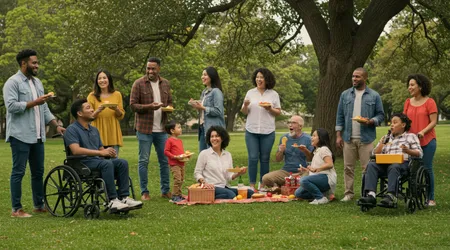How to Plan Accessible Family Gatherings

Plan accessible family gatherings that bring everyone together, regardless of ability, with thoughtful preparation.
Family reunions spark joy, connection, and memories, but ensuring inclusivity requires intention. Accessibility isn’t just a checkbox; it’s a commitment to making every guest feel valued.
In 2025, with inclusive design gaining traction, creating gatherings that accommodate diverse needs is more achievable than ever.
This guide offers practical, creative strategies to make your event welcoming, drawing from real-world insights and current trends. Let’s explore how to craft a gathering where everyone thrives.
Why Accessibility Matters for Family Gatherings
Accessibility ensures every family member can participate fully. From mobility challenges to sensory sensitivities, needs vary widely. Ignoring them risks exclusion.
A 2023 study by the CDC found 26% of U.S. adults have a disability, underscoring the need for inclusive planning. Thoughtful design fosters belonging, turning a simple event into a cherished memory.
Imagine a reunion where your aunt in a wheelchair can’t access the backyard or your cousin with autism feels overwhelmed.
++ How to Design a Morning Routine with Chronic Fatigue or Pain
Accessibility prevents these barriers. It’s like building a bridge everyone crosses together. Planning with empathy strengthens family bonds and sets a powerful example.
Moreover, accessibility reflects modern values. In 2025, inclusive practices are expected, not optional. Families who prioritize this create spaces where love and connection trump limitations, ensuring no one feels left out.

Choosing an Accessible Venue
Selecting the right venue sets the tone for inclusivity. Look for spaces with ramps, wide doorways, and flat surfaces for wheelchairs. Indoor-outdoor flow matters too.
A local community center with accessible restrooms and parking beats a charming but inaccessible historic home.
Consider sensory needs. Quiet rooms for those with sensory sensitivities can be a game-changer.
For example, Sarah, a mother of a child with autism, reserved a park pavilion with a nearby quiet tent. It worked wonders. Check venues for hearing loop systems or braille signage to aid diverse guests.
Proximity to public transport is key. In 2025, apps like AccessNow map accessible venues in real-time. Use them to verify features before booking. Accessibility isn’t just physical it’s about creating a space where everyone feels at ease.
Also read: Making Home Repairs Easier: Tools Designed with Accessibility in Mind
Venue choice also impacts logistics. A flat, open park allows easy movement compared to a multi-level restaurant. Confirm emergency exits are accessible too. Planning ahead avoids last-minute scrambles, ensuring everyone enjoys the day.
Crafting an Inclusive Guest Experience
Inviting everyone means anticipating their needs. Send out RSVPs with accessibility questions. Ask about mobility aids, dietary restrictions, or sensory preferences. Digital tools like Google Forms streamline this while keeping responses private.
Communication is critical. Offer invitations in multiple formats digital, large print, or braille. For instance, John, hosting a family barbecue, used a QR code linking to an audio invite.
It delighted his visually impaired uncle. Clear, concise language helps everyone understand event details.
Timing matters too. Schedule activities when energy levels are high, like mid-morning, to accommodate those with chronic fatigue.
Read more: Using Public Spaces When You Have a Sensory Processing Disorder
Provide clear schedules in advance. This small step empowers guests to prepare, enhancing their comfort and engagement.
Don’t overlook cultural inclusivity. Incorporate traditions that reflect your family’s diversity, like bilingual signage or culturally significant foods. These touches make everyone feel seen. A welcoming atmosphere starts with understanding your guests’ unique needs.
Engagement goes beyond logistics. Plan activities everyone can join, like storytelling or accessible games.
A photo booth with adjustable heights worked wonders at Maria’s reunion, delighting kids and wheelchair users alike. Small details create big impacts.
Food and Beverage Considerations
Food brings families together, but accessibility extends to the table. Offer diverse options gluten-free, vegan, or allergen-free to meet dietary needs. Label dishes clearly to avoid confusion. A buffet with low tables ensures wheelchair users can serve themselves.
Consider sensory-friendly options. Strong smells or loud crunching can overwhelm some guests. Offer mild flavors alongside bold ones.
At a recent gathering, Lisa included a “low-sensory” dessert table with soft textures, a hit with her autistic nephew.
Hydration stations should be accessible. Use lightweight cups and straws for those with limited grip strength. Position tables at varied heights. In 2025, smart dispensers with voice activation are emerging, making hydration inclusive and fun.
Don’t forget service. Train helpers to assist without hovering. A cousin with arthritis appreciated discreet help opening containers at a picnic. Accessibility in dining means everyone enjoys the meal, not just some.
Presentation matters too. Use contrasting colors for plates and tablecloths to aid visually impaired guests. These thoughtful choices elevate the experience, making food a unifying force.
| Accessibility Feature | Description | Example |
|---|---|---|
| Low Tables | Tables at 28-30 inches for wheelchair access | Buffet at 29 inches |
| Clear Labels | Large-print, high-contrast food tags | “Gluten-Free Pasta” in bold |
| Sensory-Friendly Options | Mild flavors, soft textures | Pureed fruit desserts |
| Lightweight Utensils | Easy-grip cups and straws | Plastic cups with handles |
Activities That Unite Everyone
Activities should spark joy for all. Choose games like trivia or charades that don’t require physical agility. For outdoor events, ensure paths are smooth for mobility aids. A family Olympics with seated games thrilled everyone at Tom’s reunion.
Sensory considerations are vital. Loud music or bright lights can overwhelm. Offer noise-canceling headphones or dimmable lighting. In 2025, portable sensory kits are trending, providing comfort for neurodiverse guests.
Involve kids and elders. Storytelling circles let everyone share. Maria’s family had a “memory lane” session where grandparents and teens swapped stories, bridging generations. Universal activities foster connection without exclusion.
Don’t assume one size fits all. Offer varied options, like quiet crafts alongside lively dances. This ensures everyone finds their niche. Flexibility is the heart of inclusive fun.
Technology can enhance engagement. Apps like Sound Amplifier help hearing-impaired guests join conversations. Test activities beforehand to ensure they’re truly inclusive, leaving no one on the sidelines.
Communication and Technology Aids
Clear communication is the backbone of accessibility. Use apps like Live Transcribe for real-time captions during speeches. These tools, widely available in 2025, empower hearing-impaired guests to stay engaged.
Signage should be clear and accessible. Large-print schedules or braille programs make a difference. At a recent reunion, Emma used digital signage with voice output, delighting her blind cousin. Technology bridges gaps when used thoughtfully.
Don’t rely solely on tech. Train family members to communicate patiently. Simple gestures, like facing someone when speaking, aid lip-readers. Empathy in communication outshines any app.
Consider hybrid options. Live-stream parts of the event for those unable to attend in person. Platforms like Zoom now offer accessibility features like auto-captions. This keeps distant relatives connected.
Test tech in advance. A glitchy app can frustrate more than it helps. Ensure Wi-Fi is strong and devices are charged. Seamless communication ensures everyone feels included.
Safety and Emergency Preparedness

Safety is non-negotiable. Ensure venues have accessible emergency exits. Train a few family members in basic first aid, focusing on disability-specific needs. A clear plan saves lives.
Medical needs vary. Ask guests about allergies or conditions discreetly. Have a first-aid kit with essentials like epinephrine pens. At a 2024 gathering, quick access to an inhaler saved a cousin’s day.
Weather can pose challenges. Provide shaded areas or indoor alternatives for heat-sensitive guests. In 2025, portable cooling vests are affordable and effective for chronic illness sufferers.
Communication during emergencies is critical. Use text alerts for quick updates. Ensure everyone knows the plan. A prepared family is a confident one, ready to enjoy without worry.
Share safety plans in advance. A simple email outlining exits and contacts reassures guests. Accessibility in safety means everyone feels secure, no matter their needs.
Budgeting for Accessibility
Inclusivity doesn’t have to break the bank. Prioritize high-impact features like ramps or braille signage. Community centers often offer affordable, accessible venues. Budget smartly to maximize impact.
Grants can help. In 2025, organizations like the National Endowment for the Arts offer accessibility funding for community events. Research local options to offset costs.
DIY solutions work too. Create your own large-print signs or sensory kits. At a budget-friendly reunion, Clara used free apps to generate accessible invites, saving hundreds.
Collaborate with family. Pool resources for costly items like portable ramps. Shared costs make accessibility feasible. Every dollar spent on inclusion strengthens family ties.
Track expenses early. Use budgeting apps like YNAB to monitor spending. Transparent planning ensures accessibility doesn’t compromise other event elements, keeping everyone happy.
Engaging the Family in Planning
Involve everyone in the process. Create a family committee to share ideas. Diverse perspectives ensure no need is overlooked. Kids’ input can spark creative solutions.
Use collaborative tools. Google Docs or Trello boards let family members contribute remotely. At a 2025 reunion, a shared board helped plan activities everyone loved.
Empower younger generations. Teens can research accessible tech or venues. Their tech-savvy ideas, like using QR codes for schedules, enhance inclusivity.
Listen to feedback. Post-event surveys reveal what worked. After one gathering, feedback led to adding more seating, improving comfort for all. Engagement builds ownership.
Celebrate contributions. Acknowledge family members who helped plan. A thank-you speech or small gift fosters unity, making accessibility a shared family value.
Frequently Asked Questions
What’s the first step to plan accessible family gatherings?
Start by asking guests about their needs via RSVPs to tailor the event.
How can I make activities inclusive for all ages and abilities?
Choose universal activities like storytelling or seated games that everyone can enjoy.
Are there affordable ways to ensure accessibility?
Yes, use free apps, DIY signage, or community venues to keep costs low.
How do I handle sensory sensitivities at gatherings?
Provide quiet spaces, noise-canceling headphones, and sensory-friendly food options.
Why should I prioritize accessibility for family events?
It ensures everyone feels included, fostering stronger bonds and unforgettable memories.
In 2025, plan accessible family gatherings that embrace every family member’s needs. Accessibility isn’t just logistics it’s about creating spaces where love shines.
By choosing inclusive venues, activities, and communication, you craft memories that last. Why wouldn’t you want every family member to feel at home?
Start planning with empathy, and watch your gathering become a beacon of unity.
